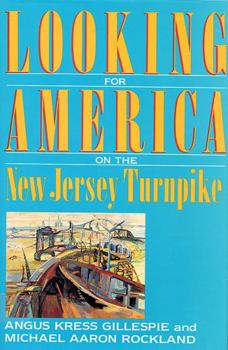Looking for America on the New Jersey Turnpike
Select Format
Select Condition 
Book Overview
Two American Studies professors from Rutgers University here show how the New Jersey Turnpike--that "ugly icon, '' America's "widest and most traveled'' road--has found its way into the minds, if not the hearts, of artists and drivers alike. In poet Allen Ginsberg, singer Bruce Springsteen, commuters and roadside home owners lulled to sleep by its drone of traffic, this 12-lane asphalt monster has inspired powerful reactions, from admiration to anger. The authors consider the first asparagus patch plowed up to lay the road; the $70,000 salary a contemporary toll-taker can earn with hefty overtime; and the not infrequent lawlessness of the highway patrol. From the gray-flannel-suit diligence that built it, to the mixture of necessity, practicality and venality that maintains it, the New Jersey Turnpike proves to be an enthralling though unlikely subject.
Format:Paperback
Language:English
ISBN:0813519551
ISBN13:9780813519555
Release Date:December 1992
Publisher:Rutgers University Press
Length:240 Pages
Weight:0.75 lbs.
Dimensions:0.5" x 6.1" x 9.0"
Customer Reviews
2 ratings
Unrestricted energy
Published by Thriftbooks.com User , 18 years ago
Bo Sullivan and the Turnpike are bundles of unrestricted energy. The New Jersey Turnpike shapes the state. The road is a triumph of function over form. It is the busiest toll road in the nation. New Jersey is a machine in the garden. The nickname, the Garden State, is, in some respects, bizarre. On the New Jersey Turnpike the patrons are treated like vagrants. The message is keep moving. The Turnpike was profitable from the beginning. It sold time and convenience. The Pulaski Skyway has been dubbed America's first cosmic road. To any student of culture, this book is a marvel.
The definitive history on the Turnpike
Published by Thriftbooks.com User , 23 years ago
As a lifelong New Jerseyan who endured the "what exit" jokes by out-of-staters (Exit 12, now that you've asked), Rockland and Gillespie try to tackle the cultural significance of the loved and loathed New Jersey Turnpike. They cite the popular reference in the Simon & Garfunkel tune, "America," and stress that the Turnpike is one of the most heavily-traveled highways in the world.What they do well is describe in entertaining detail the story on how and why the Turnpike was built (note: the secretive NJ Turnpike Authority did not cooperate with the authors when they were researching this book) and the many anecdotes about the road that bring new insights into New Jersey (and American) politics and history.The authors make two main cultural arguments throughout the book:The first one is how the negative opinion of New Jersey has been shaped over the years by travel on the Turnpike. Let's face it -- the Turnpike travels through the least attractive areas of the state. From the decayed industrial north to the straight, flat and boring stretches in South Jersey, the Turnpike is not a great public relations tool for the state of New Jersey. New Jersey is not all oil refineries (exit 12 & 13), huge megawarehouses (exit 8A) or bland suburban sprawl (exit 9 & 10), but since millions of people from around the globe have traveled on this road to or from Newark Airport or along the Northeast, they think that what they see along the Turnpike is typical to the Garden State (yes, we still have gardens).Second, the authors' argue that the Turnpike was the ultimate expression of form over function -- an idea that reached its zenith in the mid-20th century. The road was built with efficiency and safety being its highest (and perhaps only) priorities and the roadbuilders did not consider aesthetics or the concerns of neighbors or private landowners when building or maintaining the road.This book is a great and worthy complement to works like Robert Caro's The Power Broker or other works on famous roads like Rt. 66, Highway 1, the National Road (US Rt. 40), etc. You don't have to be a New Jersey-phile to enjoy this book!





